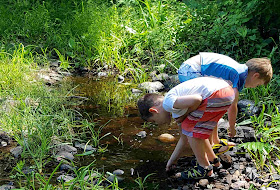by Beth Sullivan
Winter storms can be
just as bad as summer ones: wind, storm surge, precipitation and
clean up. So far we have been really lucky that our winter has been
fairly calm and not too stormy, weather wise at least. The last week
has brought some swings in the weather and a pretty good storm.
In general, these
weather events are really just part of nature’s cycles, an
opportunity to “clean house” or change things up a little.
Sometimes we can just go with it, let things happen as they should
and not try to change any outcomes. But as stewards of the land we
have protected for you, we have a responsibility to make things safe
as well. This last storm was by no means the worst we have
experienced in recent years, but it was enough to rearrange things a
bit.
 |
| After the storm, we need to walk the trails and check for issues. |
 |
| Wet land plants adapt to seasonal flooding. |
High Water
Many of our preserves
have lovely streams running through them. Often times it is those
streams that are the impetus for us wanting to protect the land
around them. The drought that lasted through summer and into the
fall dried them down to mere trickles. Over the last few months we
have had enough rain to fill them more, to restore much needed water
to the plants in the wetlands. This storm with volumes of heavy
rain drained off the land, collected the way watersheds do, and the
brooks filled to flooding. Overflowing their banks, wetlands were
drowned, but they are used to that. It is what they are supposed do:
buffer and soak and hold the water. Unfortunately some shallow
rooted trees were toppled as the soil loosened their roots, and the
winds pushed and pulled at them. Sometimes this is good, the shallow
depressions created where the roots pulled up often fill with water
and can become little refuges for amphibians and reptiles. Deeper
holes create great hollows for denning mammals.
 |
| A leaning tree has provided a den area. |
In the forests, downed
trees and branches may be a little unsightly, but they create layers
in the under story. Perches, hiding places and ultimately the
material will break down to become part of the nutrient duff on the
forest floor-recycling for the next generation. It is a nice
metaphor: one older generation making way, in a positive fashion, to
make sure things are nourished and supported as the next generation
steps in.
 |
| Trees blocking bridges need to be moved as soon as possible. |
Clearing the trails
Along the woodland
trails we have to be on the lookout for any fallen or hanging limbs
and branches that could impact a visitor, literally. Teams of
stewards have branched out over the last couple of days to clear
trails, assess threats and report back where more effort and bigger
tools may be needed. In the meantime please be careful anywhere you
walk.
 |
| Some trail blockages are not dangerous, just inconvenient. |
Coastal areas were
hammered by high water and waves. The natural salt marshes flooded,
but absorbed the strength and surge. The high water wrack line was
left with litter; the fragile edges of the marsh may have broken off
in places, but in general, thanks to the natural function of a salt
marsh, the land is mostly intact.
 |
| At Dodge Paddock, channel and grasses held though the logs were bared. |
At Dodge Paddock, the
challenge continues. While the rains flooded in from one side, the
tides pushed in from the other. Everything filled up. The drainage
ditch was compromised a bit. Erosion took place along the south face
where all the eel grass got scoured away. But most of the coir log
supports held; the grasses that were rooted held on as well. The new
marsh grasses stayed firm, collected sediment and functioned as they
should. The water drained out as it was intended. The system needs
a bit of a touch up, but so far, so good.
 |
| Fresh and salt water flooded Dodge Paddock. Photo by Jeff Callahan. |
Storms will happen;
changes in the landscape will occur. Sometimes we can let nature take
its course, sometimes we have to intervene a bit. We must always
find a balance, and that is part of the job of stewardship. And
stewardship of our environment needs support from everyone from boots
on the ground, to top administration.
Photographs by Beth
Sullivan, unless otherwise indicated.


























